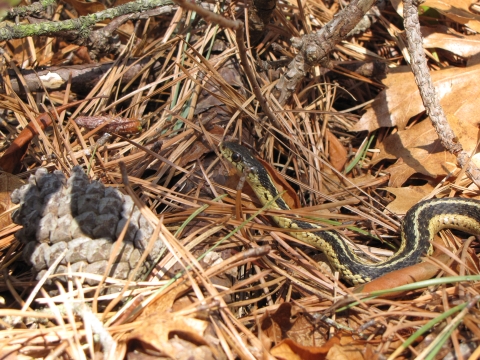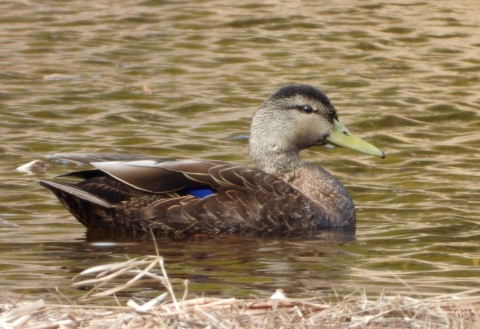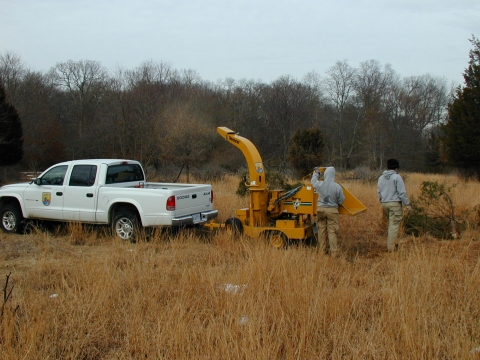Conscience Point National Wildlife Refuge is closed to the public to protect fragile wetlands.
Visit Us
The refuge is only open to select public use activities (e.g., biological research, environmental education) by Special Use Permit.
Location and Contact Information
- Conscience Point National Wildlife RefugeView Details2040 North Sea Road North Sea, NY 11968
About Us
Grasslands
The refuge preserves and maintains one of the best examples of maritime grassland remaining on Long Island. The grassland is dominated by little bluestem, with lesser amounts of Indian grass, poverty grass, and prickly pear cactus. The tidal wetlands provide habitat important for black ducks and a host of other waterbirds. Management activities are geared toward maintaining native grassland, controlling invasive species invasive species
An invasive species is any plant or animal that has spread or been introduced into a new area where they are, or could, cause harm to the environment, economy, or human, animal, or plant health. Their unwelcome presence can destroy ecosystems and cost millions of dollars.
Learn more about invasive species , and protecting habitat.
Maritime grasslands are a globally rare plant community found on outwash plains near oceans or bays. Fewer than 100 maritime grasslands are found worldwide. Since 1989, the State-listed coast flatsedge and bushy rockrose have been recorded at the refuge. Historically, several other listed plants associated with maritime grasslands were known there. The rarity of the maritime grassland habitat type on Long Island is due partly to the rapidity which the vegetation succeeds into maritime shrubland and the absence of disturbance, e.g. fire, to reduce the spread of woody vegetation.
Wetlands
Conscience Point is part of a unique wetland network: the Sebonac Creek/West Neck/Scallop Pond System or, in local vernacular, the Cow Neck Complex. That system encompasses about 300 acres of open water, salt marsh salt marsh
Salt marshes are found in tidal areas near the coast, where freshwater mixes with saltwater.
Learn more about salt marsh , irregularly exposed tidal flats, and aquatic beds. The Cow Neck Complex includes large, privately owned wetlands and wetlands owned by The Nature Conservancy.
The extensive salt and brackish tidal marshes include a number of tidal creeks, ponds and coves. The marshes characteristically comprise low and high marsh areas dominated by smooth cordgrass and saltmeadow cordgrass, respectively, with various admixtures of glasswort, spikegrass, black grass, and sea lavender, among others. Their upland shrubby edges often are dominated by groundselbush, marsh elder and bayberry, grading into upland forest of red maple and white oak.
What We Do
Refuges deploy a host of scientifically sound management tools to address biological challenges. These tools span active water management to wilderness character monitoring, all aimed at ensuring a balanced conservation approach to benefit both wildlife and people. At this field station our conservation tool box includes:
Invasive Species
Invasive plants are a threat because they displace native plant and animal species, degrade wetlands and other natural communities, and reduce natural diversity and wildlife habitat values by out-competing native species for light, water, and nutrients. Invasive plants do occur on the refuge and threaten both aquatic and terrestrial systems.
Once invasive plants have become established, their characteristic abilities to establish easily, reproduce prolifically, and disperse readily make getting rid of them expensive and labor-intensive. Many of them cause measurable economic impacts, particularly in agricultural fields. Preventing new invasions is extremely important for maintaining biodiversity and native plant populations. Controlling affected areas requires extensive partnerships with adjacent landowners and state and local government agencies.
Invasive species that may pose a threat to refuge resources include black locust, mile-a-minute, common mullein, Japanese barberry, wineberry and phragmites.
Prescribed Fire
This management technique benefits a variety of natural resources. In areas of Long Island where prescribed fire has been used, the refuge has been able to reduce fuels for protection from wildfire and restore a natural ecological process—fire—to wildlands. Burning helps to maintain fire dependent vegetation (pitch pine, warm seasonal grasses), manage grasslands, remove non‑native plants and improve feeding and nesting areas for wildlife.
Our Species
Garter Snake
Garter snakes are one of the more common snakes found on Long Island, usually near moist areas such as marshes or forest edges. Active during the day and in the evening, they can usually be found chasing prey species such as frogs, earthworms, small fish and/or tadpoles. In winter, garter snakes hibernate under large rocks or inside burrows made by different animals. If attacked, a garter snake will release a bad-smelling odor.
Black Duck
The Cow Neck Complex is known for its high concentration of black ducks. Waterfowl numbers are highest in the colder months, and decline in the warmer months. Black ducks are by far the predominant waterfowl species using the refuge. The area is considered to be regionally significant for black ducks, both as breeding and wintering habitat; wintering black duck densities on and near the refuge are among the highest for Long Island. Because of those factors, the Peconic Estuary Program has tentatively identified the Cow Neck Complex as significant habitat for black duck. Other common waterfowl species include bufflehead, Canada goose, red-breasted merganser, and mallard.
Projects and Research
Grassland Restoration
Refuge staff restored historic grassland areas by removing young red cedar and oak trees in former grassland areas using a low-ground pressure mower. Removal of red cedar and oak allows native grasses and other plants to grow in these areas, as well as reducing hazardous fuels and decreasing the possibility of wildfires on the refuge. Grassland restoration provides improved habitat for grassland birds such as eastern meadowlark, bobolink, and savannah sparrow, as well as rare plants and animals.






















